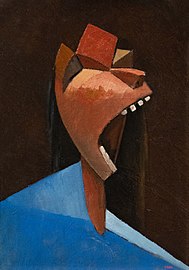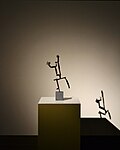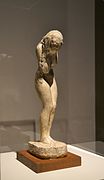Julio González (sculptor)
Julio González | |
|---|---|
 Julio González, 1912 | |
| Born | Julio González Pellicer 21 September 1876 Barcelona, Spain |
| Died | 27 March 1942 (aged 65) Arcueil, France |
| Education | Cercle Artístic de Sant Lluc |
| Known for | Painting, Sculpture |
| Movement | Cubism |
Julio González i Pellicer (21 September 1876 – 27 March 1942), born in Barcelona, was a Spanish sculptor and painter who developed the expressive use of iron as a medium for modern sculpture. He was from a lineage of metalsmith workers and artists. His grandfather was a goldsmith worker and his father, Concordio González, a metalsmith worker who taught him the techniques of metalsmith in his childhood years.[1] His mother, Pilar Pellicer Fenés, came from a long line of artists.
González attended Circol Artist Sant Luc, a Catholic school whose model of education was based on the medieval art guilds and influenced by the Arts and Crafts movement in England.[1]
Biography
Early life
Julio González Pellicer was born in
By the turn of the 20th century, Pablo Picasso and González became great friends. González moved to Paris in 1902, but traveled to Barcelona several times in the early 20th century. At the Picasso Museum in Barcelona, their close friendship is verified by a drawn portrait, entitled "Julio González and the Robust Man Seen from Behind".[3] They remained close friends until 1908; scholars do not know why their friendship ended at this time, but based on González archival materials, it appears to be related to an earlier dispute with Julio's brother, Joan.[4]
Paris
In Paris he associated with the Spanish circle of artists of
-
Cap cridant, Museu Nacional d'Art de Catalunya
-
Sef-portrait 1920, Museu Nacional d'Art de Catalunya
-
Visage criant a la grande main, 1941.
-
Self portrait, 1920, Institut Valencià d'Art Modern[edit]
Ironwork (1932–1937)
González created ironwork at this time that would establish him as "the father of all iron sculpture of this century".
Later years (1938–1942)

In the late 1930s González worked with naturalistic and abstract forms. The art he produced during this period, similar to other Spanish loyalist republican artists living abroad during the Spanish Civil War, reflected the pain and torment they felt. Significant amongst these pieces was his 1939 abstract sculpture Monsieur Cactus (Cactus Man I) which was influential on the development of avant-garde sculpture. Several of the exploratory drawings for the sculpture " .... suggest that the figure is shrieking; the prickly nails intensify the aggressive effect of the work, recalling Picasso’s use of nails in his Guitar of 1926." [7]
As González aged between 1938 and 1940, he drew more.[8] These later works, as scholar Joseph Withers states, “touch on larger problems and personal concerns which necessitated our discussion of these works in the context of González's evidently pessimistic reaction to the Spanish Civil War and the Second World War.[8] González was directly affected by the Second World War; his daughter Roberta González married German painter—and Julio's assistant—Hans Hartung in 1938.[4] When the German invasion occurred in France, the couple had to separate from the rest of the family since Hans Hartung was an anti-Nazi and was wanted by the German secret police.[4] While separated from his daughter and son-in-law, González drew figurative drawings and worked on plaster casts. The drawings and castings produced during the last two years of his life are testimonies to the suffering and despair González felt towards tyranny and war.[1] González died in Arcueil on March 27, 1942.
Public collections
The
The biggest collection of this artist's work is held by the IVAM (Valencia's Institute of Modern Art), in the city of Valencia, Spain, with close to 400 pieces.[9]
Gallery
-
Mà gitada (Main couchée), 1937, wrought iron, 19 x 29,5 x 2,7 cm. Institut Valencià d'Art Modern
-
Ballarina amb margarida, (Danseuse à la marguerite), 1937, wrought iron, 48,3 x 29,2 x 10 cm, Institut Valencià d'Art Modern
-
Màscara de Montserrat cridant (Masque de Montserrat criant), bronze, 32,8 x 14,9 x 12 cm, c. 1938-39, Institut Valencià d'Art Modern
-
Petite masque baroque (Xicoteta màscara barroca), wrought iron, 12,5 x 11,2 x 1,8 cm, c. 1927-1929, Institut Valencià d'Art Modern
-
Dona davant l'espill (Femme au miroir), wrought iron, 208,8 x 60 x 46 cm, c.1936-1937, Institut Valencià d'Art Modern
-
Cap de Montserrat cridant (Tête de Montserrat criant), 1942, chalk, 32 x 20 x 30 cm. Institut Valencià d'Art Modern
-
Nu dempeus melangiós (Nu debout mélancolique), c. 1910-14, chalk, 26'5 x 6'5 x 9'5 cm, Institut Valencià d'art Modern
-
Femme coiffant une jeune fille (Mujer peinando a una joven), c. 1912-14, Museo Nacional Centro de Arte Reina Sofía, Madrid
-
Maternité au clocher (Maternidad del campanario), c. 1920-28 Museo Nacional Centro de Arte Reina Sofía, Madrid
-
La petite faucille (La pequeña hoz), c. 1937, bronze, Museo de Escultura al Aire Libre de la Castellana, Madrid
References
- ^ a b c d e f Llorens, Tomas (1985). Julio Gonzalez: En La Collecion de L'IVAM. Generalitat Valenciana Conselleria de Cultura. pp. 15–52.
- ^ a b "Julio González. The IVAM collection". IVAM Exhibition Leaflet. 2013.
- ^ "Museu Picasso". Catalogue. Archived from the original on 2016-01-27. Retrieved 2016-01-19.
- ^ a b c Aguilera Cerni, Vicente (1973). Julio Joan Roberta Gonzalez: Interario de Una Dinastia. Barcelona, Spain: Ediciones Poligrafa, S.A. – Balms, 54. p. 44.
- ^ a b c d Le Monde, Julio Gonzalez, la révolution du fer, 4 July 2007 (in French)
- ^ a b Rowell, Margit (1987). González: Catalogue Raisonne Sculpture. Spain: Electa. pp. 332–337.
- ^ "Julio González "Monsieur " Cactus (Cactus Man I)".
- ^ a b Withers, Josephine (1978). Julio Gonzalez: Sculpture in Iron. MW Books. p. 94.
- ^ "Julio González artworks preserved at Valencia's IVAM". Archived from the original on 2011-09-13.
Further reading
- Nancy Marmer, "Julio González: Sculpture in Iron," Art in America, November/December 1978, pp. 23–24.
External links
- Guggenheim Museum biography
- The Legacy Project, Visual Arts Library
- Spanish Painters, biographies
- IVAM (Valencia’s Institute of Modern Art)
- Julio González in American public collections, on the French Sculpture Census website




![Self portrait, 1920, Institut Valencià d'Art Modern[edit]](http://upload.wikimedia.org/wikipedia/commons/thumb/5/52/Julio_Gonzalez_portrait.jpg/227px-Julio_Gonzalez_portrait.jpg)









